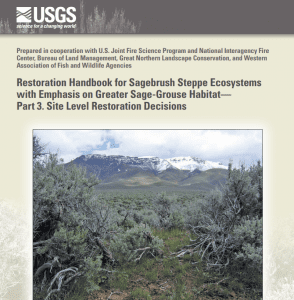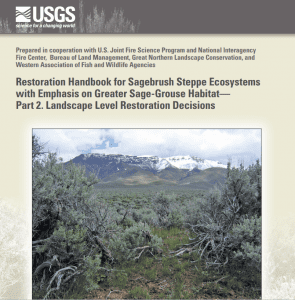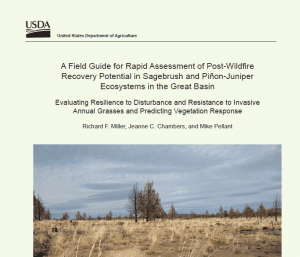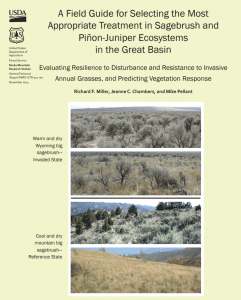Field Guide
View guide.
This guide, which includes the basic biology, life stages and habitat needs, habitat components, sagebrush monitoring, conservation planning in Wyoming, and predator impact, is intended to enhance understanding of sage-grouse conservation in Wyoming. Greater sage-grouse conservation, put simply, is understanding the needs of the sage-grouse for each life stage,knowing the life stage you provide habitat for, knowing what threats exist on the land, and implementing actions on the land to minimize or reduce the threats.
View handbook.
This handbook walks managers and practitioners through a number of site-specific decisions managers face before selecting the appropriate type of restoration. This site-level decision tool for restoration of sagebrush steppe ecosystems is organized in nine steps.
- Step 1 describes the process of defining site-level restoration objectives.
- Step 2 describes the ecological site characteristics of the restoration site. This covers soil chemistry and texture, soil moisture and temperature regimes, and the vegetation communities the site is capable of supporting.
- Step 3 compares the current vegetation to the plant communities associated with the site State and Transition models.
- Step 4 takes the manager through the process of current land uses and past disturbances that may influence restoration success.
- Step 5 is a brief discussion of how weather before and after treatments may impact restoration success.
- Step 6 addresses restoration treatment types and their potential positive and negative impacts on the ecosystem and on habitats, especially for greater sage-grouse. We discuss when passive restoration options may be sufficient and when active restoration may be necessary to achieve restoration objectives.
- Step 7 addresses decisions regarding post-restoration livestock grazing management.
- Step 8 addresses monitoring of the restoration; we discuss important aspects associated with implementation monitoring as well as effectiveness monitoring.
- Step 9 takes the information learned from monitoring to determine how restoration actions in the future might be adapted to improve restoration success.
View the guide.
The primary purpose of this guide is to serve as a tool for communicating potential particulate matter (PM2.5) levels during wildfire events using visual representation. Examples of visibility impairment under various levels of smoke concentration and humidity have been modeled using the WinHaze program.
View handbook.
This handbook is intended to assist decision makers in determining landscape objectives, to identify and prioritize landscape areas where sites for priority restoration projects might be located, and to aid in ultimately selecting restoration sites guided by criteria used to define the landscape objectives. The landscape restoration decision tool is structured in five sections that should be addressed sequentially. Each section has a primary question or statement followed by related questions and statements to assist the user in addressing the primary question or statement.
View handbook.
This handbook discusses concepts surrounding landscape and restoration ecology of sagebrush ecosystems and greater sage-grouse that habitat managers and restoration practitioners need to know to make informed decisions regarding where and how to restore specific areas, by providing:
- Descriptions of plant dynamics of sagebrush steppe ecosystems and their responses to major disturbances, fire, and defoliation.
- Introductions of the concepts of ecosystem resilience to disturbances and resistance to invasions of annual grasses within sagebrush steppe.
- Introductions to soils and ecological site information will provide insights into the specific plants that can be restored in a location.
- Descriptions of concepts of landscape ecology that aid decisions regarding habitat restoration.
- Overviews of restoration techniques for sage-grouse habitat restoration.
- Descriptions of the critical nature of monitoring for adaptive management of sagebrush steppe restoration at landscape- and project-specific levels.
View field guide.
This field guide provides a framework for rapidly evaluating post-fire resilience to disturbance, or recovery potential, and resistance to invasive annual grasses, and for determining the need and suitability of the burned area for seeding. The framework identifies six primary components that largely determine resilience to disturbance, resistance to invasive grasses, and potential successional pathways following wildfire, as well as the information sources and tools needed to evaluate each component.
The components are: (1) characteristics of the ecological site; (2) vegetation composition and structure prior to the wildfire; (3) fire severity; (4) post-wildfire weather; (5) post-wildfire management, especially grazing; and (6) monitoring and adaptive management.
The tools provided are: (1) a conceptual model of the key components that largely determine resilience to disturbance and resistance to invasive annual grasses of the burn area, (2) a guide to evaluate post-wildfire severity, (3) indicators to estimate pre-wildfire plant composition and structure if not known, and (4) an evaluation score sheet to rate an area’s potential post-wildfire resilience to disturbance, resistance to invasive annual grasses and, thus, the need for seeding and probability of success.
View guide.
Virtual field guide contains information about Idaho’s noxious weeds: best control methods available to manage that weed and links to other sources for more education and information.
View guide.
In this study, researchers modeled the climatic envelope for subspecies wyomingensis for contemporary and future climates (decade 2050). Comparison of the contemporary and decade 2050 models shows a predicted 39% loss of suitable climate. Much of this loss will occur in the Great Basin where impacts from increasing fire frequency and encroaching weeds have been eroding the A. tridentata landscape dominance and ecological functions. The goal of this study is to provide a management tool to promote successful restoration by predicting the geographic areas where climate is suitable for this subspecies.
View field guide.
This field guide identifies seven primary components that largely determine resilience to disturbance, as well as resistance to invasive grasses and plant succession following treatment of areas of concern. An evaluation score sheet is included for rating resilience to disturbance and resistance to invasive annual grasses and the probability of seeding success.






